THE CHINESE
of

(If you can read the characters above, they make the sound of "Columbia.")
1850 - 1963
(Any other names used below were found in the historic record.)
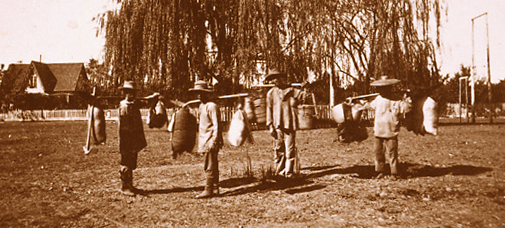
© Columbia State Historic Park.
Four Chinese Miners in Columbia with mining tools - c1866.

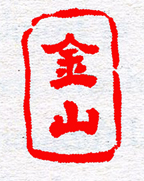
The first major wave of Chinese immigrants to Gum-Sam (Gold Mountain) was during the gold rush. They began arriving in San Francisco in 1849. In 1850 There were only 500 Chinese men out of the 57,787 immigrants arriving in California. The conditions in China by 1851 during the Taiping Rebellion (1851-1864) made life unbearable. Millions were killed in bloody warfare. By 1852, 11,794 Chinese were living in California and only 7 were women. Some estimates show that at one time there were 1000 to 2000 Chinese in the Columbia area alone.
First Chinatown - 1851
Earliest locations for Chinatown points to the west of Broadway near Gold Springs Road. Hubert E. Brady stated "Columbia's first Chinatown was located on the north side of Gold Springs Road, across the road from the Peabody, the Ellis and Schoettgenn homes, in the 1850's." He states that "there were two China stores, two stories tall in a small area of 550' x 150' were 1500 or more Chinamen lived." Maps of Block 4D and 23B show location of two Chinatowns on north and south side of Gold Springs Road, formerly on the site of Long's Lumber Yard and later on property of E. S. Jarvis.(E1:12:3)
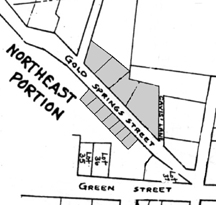
Map showing approximate locations of early Chinese dwellings - 1851.
Another location was started early when "a few of the Chinese merchants suceeded in obtaining leases from Frenchmen that owned property on Main Street, between Jackson and Pacific Streets." (from H.E. Brady)
There was suppose to be a Joss house north of the Claverie Bldg. (ruins) two stories high decorated with many red banners. Despite these reports historian Allen Welts was unable to verify the existence of a Chinese temple building anywhere in Columbia. (Welts 1973:1; Appenix B)
There was also a Chinese theatre at this time with a canvas roof and dirt floors with 40 male actors doing
male and female roles.
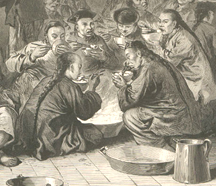
Chinese eating a meal aboard ship.
1851 There were four Chinese Chop-Shops (Restaurants) and one Chinese laundry on Washington, Broadway, and State Streets. (Ref. Chinese in Columbia, A Historical Summary by Allen Welts, 1964 - from DMP #725-98-00161)
Chinese food was a novelty as well as a delight to the rather bland American food at the time. "The Chinese menu included dried oysters, abalone, cuttlefish, bamboo sprouts, mushrooms, five kinds of vegetables, pork, poultry, vermicelli, rice, salted cabbage, dried seaweed, sweet rice crackers, sugar, four kinds of dried fruit, Chinese bacon, peanut oil, and tea. Seemingly, this was the forerunner of the modem American well-balanced diet. The fare of the Caucasian laborer consisted of beef, beans, bread, butter, and potatoes." (Robert F. G. Spier, "Food Habits of Nineteenth Century California Chinese," California Historical Society Quarterly, XXXVII) One more interesting feature less known is the terrace gardens located in the southeastern section behind maintenance that the Chinese grew many herbs, spices, vegetables, etc.

© Columbia State Historic Park.
Location of Chinese terrace gardens southeast of town.
1851 A State Street lot has a Chinese Chop-Shop (Restaurant) next to Joel Levy's.(E1:16:4)
Chinese Burying Ground Section I, of the Historic Columbia Cemetery, created during the gold rush era, has 473 found grave plots which includes 55 unmarked plots. The first burials at this site are known today (1991) to have been Chinese people who were buried there during the 1852-55 era. When the first Caucasians were buried in 1855 many Chinese graves were uncovered. Their remains were set aside and placed at the bottom of the new grave being excavated. As recent as 1933 Chinese graves were still being uncovered, within the southwesterly area of Section I. There are no known records of their final resting place. (Hart Ralph Tambs August 31, 1991) It is known that many Chinese were sent back to their homeland to be entered there in family plots.
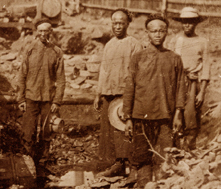
Chinese labor force 1851.
1852 April 11 - At or near Mountain Brow we had "50 Celestials on their way to the mines..." join up with us and when we camped, trying to sleep, with "the Cinese camp here also," (they would) "make night hideous by their uncivilized 'Powwow', which was kept up all night." - (The Journal of Stehen Chapin Davis.)
(most likely a celebration of Spring? - WebMaster)
Anti-Chinese laws
1852 Democrat Govenor John Bigler enacted a policy to prevent Chinese immigrants from entering California. Bigler claimed that the Chinese refused to and could never assimilate into American society, and he also used the immigrants' willingness to work for little pay as a way to urge Californians to "check this tide of Asiatic immigration." While the previous administration of Democrat Governor John McDougall somewhat supported the Chinese presence in the state (promoting the removal of blacks and Indians), Bigler advocated the revival of the 1850 Foreign Miners Tax, originally signed by anti-foreigner Democrat Governor Peter Burnett. Whereas the original 1850 law placed a $20 per month tax on all miners of foreign origin, the Bigler-supported 1852 version of the law placed a $3 per month tax exclusively for Chinese laborers. Over the course of his two terms in office, taxes for Chinese immigrants steadily increased, with ever harsher bills passing the Legislature and signed into law by Governor Bigler. One law passed by the Legislature and signed by the Governor created a $50 tax per head (to be paid within three days) for Chinese entering Californian ports. The California Supreme Court later ruled the law unconstitutional.
1852 May 5 - Opposition to the constriction of Chinese immigration was voiced by Norman Asing, a leader in San Francisco's Chinese community, in an open letter published in a newspaper. He argued that "...we are not the degraded race you would make us" and that "...when your nation was a wilderness, and the nation from which you sprung barbarous, we exercised most of the arts and virtues of civilized life;" therefore, the Chinese should be free to contribute productively to the US.(See full letter) - Norman Asing (May 5, 1852). "To His Excellency Gov. Bigler". Daily Alta California.
1852 May 8 - A meeting is held by a few Columbia miners to "protect" the town from the evils of too many Chinese. But nothing was really done to rid the town of Chinese. They offered too many other services that single miners required; better food, washing clothes, etc. The Chinese miner bidded his time to when the caucasion miners were "done" with their claims.
1852 October 2 - The China Wash House on Washington Street. East of property mortgaged by J. P. McClenahan. (E1:3:23)
On South side of Washington Street, east of property opposite Boston Bakery on North Side. Caleb Dorsey & Co. purchased the mortgage from McClenahan for $150.00 the property bounded on the east by China Wash House and on the west by the Ticonic Hotel. (Block 3A, Lot 44).
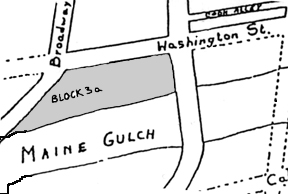
Block 3a where Chinese had businesses - 1852.
1852 Nov. 10 - Gidding, a German, murdered and robbed near Campo Seco by two Chinamen. (Source: A History of Tuolumne County, California - San Francisco: B.F. Alley, 1882)
1852 Nov. 13 - The Columbia Gazette runs this article claiming that the Chinese are not a problem in the community.
1852 December 31 - Chinese Chop-Shop (Restaurant), Solomon Samson & Co. - Mortgage to W. Bancock. (Block 3A, Lot 44).
George Kowgun was the leader among the Chinese in Columbia at this time. (E1:15:72) (probably a benefactor "tong" to some of the men who may have been indentured to him. He was owner of some Chinese women slaves used for prostitution, gambling houses, and had opium dens under his control.)
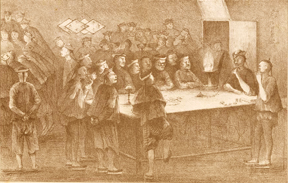
Chinese loved to gamble.
1853 January 12 - Sam Sing & Chin Hop Mortgage their Chinese Chop-Shop (Restaurant) to D. A. Hollister.(Block 3A, Lot 44)
1853 February 1 - George Kowgun bought at a Constable's Sale the John Esaw & Co. Chop-Shop (Restaurant), next west of Levy property at south west corner of State and Main.(E1:16:72)
1853 July 27 - Each nation generally keep their own public houses where there is many of their people at one place...the Chinese (keep) boarding houses. I generally take meals at their houses when I go (from Yankee Hill) to town (Columbia). They keep the best "table" of any. (from a letter by David Baer Hackman in A Pennsylvania Mennonite and the California Gold Rush by Lawrence Knoor 2008)
1853 September 23 - A sheriff's sale for Stacey Bennet & Turner vs H.S. Drew mentions a piece of property that is being sold for debts as "situated on Broadway, nearly opposite George (Kowgun?) Chinaman's Restaurant." (J.L. Connor, Constable)
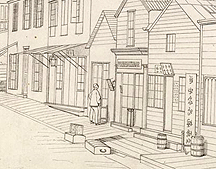
Typical Chinese store fronts - 1854.
Second Chinatown - 1854
The Gold Hill that was once the first cemetery located just to the west of the first Chinatown became rich and the burial plots as well as the Chinese were displaced to a new location (Present day cemetery, to the rear of school house). At this time there were many buildings on the east side of Main Street just below Pacific Street that constituted the next Chinatown. The streets were looked much like a typical Canton village. Buildings close together. Single entrance with little space between. Scrolls and red cupolas trimmed in gold gave the Chinese the feeling of their home towns in China. Across the street were Mexican Fandango Houses and south of Chinatown, towards Jackson Street, stood many French establishments. The French continued to get along well with the Chinese.
1854 April 7 - Asked by his brother how the female population was in Columbia, Hackman answered, "...whether I have any ladies here, I would state that I have none. But there are a great many women here - mostly all foreigners and of these the Chinese are the most numerous." (from a letter by David Baer Hackman in A Pennsylvania Mennonite and the California Gold Rush by Lawrence Knoor 2008)
1854 A Chinese Boarding House was on the same lot at State Street as the Chop-Shop (Restaurant) in 1851. (E1:16:4)
1854 June - George Kowgun, running a Chinese boarding house, transfers the property to Isaac Shotwell. (E1:16:72)(Block 3A, Lot 44)
1854 June 19 - China woman (prostitute) found murdered near Shaw's Flat. Supposed to have been the victim of her countrymen.(Source: A History of Tuolumne County, California - San Francisco: B.F. Alley, 1882)
1854 July 10 - The day of the first big conflagration in Columbia. Sam Hang (The card says "Doubtless a Chinaman.") who was then on Washington Street, listed as having a loss of $600 in great fire. "He probably had a shop or laundry."
1854 July 10 - Chinese boarding house burns at State Street and is replaced with another frame structure.
1854 July 10 - George Chinaman lived on State Street and had a loss of $1000 in the fire. Also "Two China House" Loss $500.
1854 July 10 - John Chinaman on Washington Street loss $500 and Miss "dodo" (means ditto to above, i.e., "Chinaman") loss $200 (prostitute) and another John $200 in the fire.
1854 John Hang sells to Vincent Magendie two houses occupied by Chinese. Assessed to Ah Chee Company.
1854 July 22 - Chinese laundry was replaced with a new frame building. Location was probably on east side of lot where Eagle Cottage was built, as deed in connection with that lot mentions a "China Wash House" on its eastern side. (another note found, states that Sam was actually Choon Hang and had the China Wash House next to Eagle Cottage. He bought it from Ah Chen lot 3a/44)
1854 July 31 - The new Chinese boarding house sells to Morris Michael.
1855 Feb. 9 - Chinaman shot and killed in Jacksonville by the Tax Collector, while resisting that officer.(Source: A History of Tuolumne County, California - San Francisco: B.F. Alley, 1882)
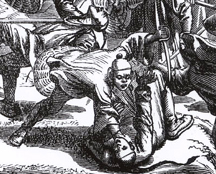
Chinese war - Charles Nahl.
1856 Oct. 25 - War among the Chinese at Rock River Ranch-four of them killed.(Source: A History of Tuolumne County, California - San Francisco: B.F. Alley, 1882)
Established 1857 Chinese Burying Ground is just north of lot owned by S. G. Bailey on north side of Green Street. (E1:4:13 or 8)
1857 June 26 - William Davis hanged at Sonora for the murder of a Chinaman in 1855. (Source: A History of Tuolumne County, California - San Francisco: B.F. Alley, 1882) Columbia Fusileers were forced to act in the grim role as guards for death, when on Friday, June 26, 1857, William V. Davis, who had been convicted of the murder of a Chinese immigrant in the vicinity of Stanislaus, was executed in the presence of a large crowd. The Columbia Fusileers, at the request of the civil authorities were on guard the entire day, the purpose being to protect the inmates imprisoned there, for fear of an attack by the citizens on the County Jail. (San Francisco Daily Herald, June 28, 1857, Page 3, Column 2.)
1857 July 15 - Three Chinamen moved from northwest of Gold Springs Road near a claim of Cross & Co. where they were originally interred.(Columbia Burial Ground Register of Deaths by B. Eastman 1959)
1857 July 24 - China woman interred in China plot. Thought to be 20 years old and a prostitute who poison herself.(Columbia Burial Ground Register of Deaths by B. Eastman 1959)
1857 August 25 - George Kowgun bought from Louis Lippmann property on south east corner of Jackson & Broadway for $1250.00. Fire started by a Chinaman cooking around 6pm destroyed all of Chinatown and Columbia proper. (E1:15:72)
The town fire started next door, reportedly in a Chinese dwelling, on a lot owned by a Frenchman known as Aime Bonnifoi. According to local histories, a Chinaman "cooking his supper ran out into the street to see what a commotion was and returned to find his cloth walls on fire" (Welts 1973:2).
1857 September 18, 1857 - "The authorities of Columbia have passed an ordinance requiring the Chinese to leave town within a specified time. It is necessary for the safety of the place." (from the Sacramento DSS)
1857 September - the third Chinatown is removed to the location of the present day Columbia Airport.
1857 September 12 - Kowgun returned the property to Lippmann taking a $200.00 loss.
1857 Many of the prostitutes chose to set up "house" in many of the French boarding houses or shanties, instead of being forced out of town. (Union Democrat April 23, 1864) At first there were a few citizens (blacks and whites) who didn't want them there, but the French defended them.
1857 October - The Chinese "started to move down into the center of town. Upper Main Street and Jackson Street were owned principally by Frenchmen, who were more than willing to rent to the Chinese. They soon became well established and from that time on all of upper Main Street between Jackson and Pacific Streets was Chinatown." (CSHP Archives record, page 2) Many stories were told that the Chinese were run out of Columbia for "years" after the fire "they" started, yet the record has them back in force in less than three months.
1858 January 17 - "The worst class of Chinese women (prostitutes) are coming into Columbia again; it was hoped after the fire, that they would be kept outside of the corporate limits. But there are white men who are willing to do almost anything in worship of the almighty dollar, even to encourage the presence of these women." (The Alta; newspaper).
1858 February 14 - Three Chinawomen (prostitutes) and one man shot and buried in "China Plot" of the cemetery.
1858 May 17 - Cum Sow, Chinaman, killed in Columbia; probably by white men. (Source: A History of Tuolumne County, California - San Francisco: B.F. Alley, 1882)
1858 The Chinese continued to return one man at a time. The following are listed on the map as indicated.
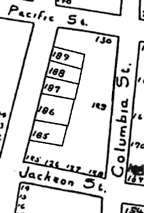
Map showing some of the Chinese claims - 1858.
1858 East of Main Street had six little Chinese houses were Chinese miners lived. (Eastman Map Lot 186)
1858 Ah Mows Store. (Eastman Map Lot 187)
1858 Ah Mows Theatre (corner of Pacific). (Eastman Map Lot 188)
1858 Chinese Slave Dealer. (George Kowgun?) (Eastman Map Lot 189)
1858 Three little Houses owned by Chinese Miners. (Eastman Map Lot 190)
1858 May 24 - a Chinaman shot and buried in "China Plot" of the cemetery. (Columbia Burial Ground Register of Deaths by B. Eastman 1959)
1858 August 7 - A Chinaman buried in "China Plot" of the cemetery. (Columbia Burial Ground Register of Deaths by B. Eastman 1959)
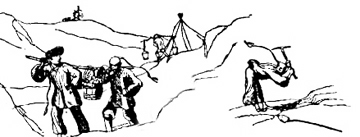
Chinese Miners by Nahl.
1858 Chinese Store (brick) (Eastman Map Lot 191)
1858 Lin Sing's Store (formerly Charlie Macon's) Quy Quo a merchant who lost his business due to a bad deal by Ah Mow.
He was General manager for Ling Sing & Co(?) (Eastman Map Lot 193)
1858 Chinese Burying Ground lot acquired by Sam Dealy.
(E1:4:13 or 8)
1859 May 16 - A Chinawoman (prostitute) buried in "China Plot" of the cemetery. Reason for death: "Childbed" (childbirth?). (Columbia Burial Ground Register of Deaths by B. Eastman 1959)
1860 Census for Columbia shows 29 buildings, include six merchants in three separate buildings, a butcher shop, a drug store with doctor, two hotels and a silversmith, tailor and laundryman. (Eastman1:23:11)
1860 February 5 - A Chinaman buried in "China Plot" of the cemetery. Reason for death: "Cold." (Columbia Burial Ground Register of Deaths by B. Eastman 1959)
1860 May 15 - A Chinaman buried in "China Plot" of the cemetery. Listed as a "Miner."

Chinese businesses in Columbia from the July 1860 Census.
George Kowgun 34 year old "Miner" (Benefactor and slave owner) Chinese with $2500 worth.(P78-L11)
Berry Kowgun 19 year old female (prostitute) (living with George) (P78-L12)
George Kowgun was the owner of 32+ female prostitutes according to the 1860 census. They all lived in Chinatown, Columbia. (See Professional Women)
Ah Fee 27 year old cook (in Chinese Chop Shop?) from Mongolia. (Page 79-Line 26)
Ah Tung 34 year old cook (in Chinese Chop Shop?) from Mongolia. (P79-L36)
Ah Hie 40 year old clerk (in Chinese Shop?) from Mongolia worth $300. (P78-L23)
Ah Sam 34 year old clerk (in Chinese Shop?) from Mongolia. (P79-L37)
Ah Hune 45 year old druggist (in Chinese Herb Shop?) from Mongolia worth $500. (P78-L25)
Ah Sum 22 year old druggist (in Chinese Herb Shop?) from Mongolia worth $500. (P78-L32)
Ah Them 26 year old druggist (in Chinese Herb Shop?) from Mongolia. (P78-L33)
Ah Ti 20 year old gardener (in Chinese Grocer?) from Mongolia worth $500. (P82-L34)
Ah Yow 35 year old gardener (in Chinese Grocer?) from Mongolia. (P82-L35)
Ah Odd 32 year old gardener (in Chinese Grocer?) from Mongolia worth $500. (P82-L36)
Ah Young 25 year old gardener (in Chinese Grocer?) from Mongolia. (P82-L34)
See Young 40 year old Hotel Keeper from Mongolia worth $500. (P78-L17)
Ah Chum 30 year old Hotel Keeper from Mongolia worth $500. (P78-L18)
Ah Lee 40 year old Hotel Keeper from Mongolia worth $200. (P78-L19)
Ah Cum See 30 year old Hotel Keeper from Mongolia worth $200. (P78-L30)
Ah Sherm 26 year old Hotel Keeper from Mongolia. (P78-L31)
Ah Tuck 35 year old Laborer from Mongolia. (P79-L6)
Ah Teny 46 year old Laborer from Mongolia. (P82-L18)
Ah Sucum 30 year old Merchant from Mongolia worth $500. (P78-L13)
Ah Koo 35 year old Merchant from Mongolia worth $500. (P78-L14)
Ah Shim 35 year old Merchant from Mongolia worth $800. (P78-L20)
Ah Hee 38 year old Merchant from Mongolia worth $300. (P78-L22)
Ah Cum Hem 40 year old Merchant from Mongolia worth $600. (P78-L28)
Ah Kao 35 year old Merchant from Mongolia. (P78-L29)
Ah Hang 48 year old Merchant from Mongolia worth $600. (P78-L29)
Ah Chera 48 year old Merchant from Mongolia worth $600. (P79-L30)
Hoop Lee 30 year old Merchant from Mongolia worth $500. (P79-L35)
Ah Fook 32 year old Merchant from Mongolia worth $800. (P79-L38)
Ah Sung 38 year old Merchant from Mongolia worth $1000. (P79-L39)
Ah Pang 61 year old tailor from Mongolia. (P79-L28)
Ah Tung 50 year old trader from Mongolia worth $1000. (P9-L31)
See Professional Women for the Chinese Slaves From the July 1860 Census listed as a prostitute.
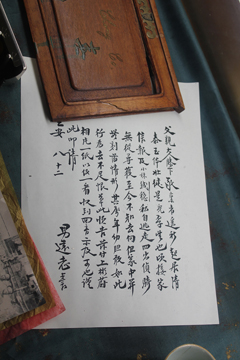
© Columbia State Historic Park.
Copy of letter in Museum - FDPØ.
Our Museum, in Columbia, displays (currently-2013) a very wonderful and highly respectful letter from a young man to his father.
Here is the translation in english:
"Honored Father,
I read that you are still healthy and can take care of yourself. This is what your son wishes for. I just received a letter from home, reporting that little sister (Chin Wai) secretly ran away. Searching for her everywhere but she could not be found. Throughout our family history, we had never treated anyone unfairly or unkindly. She is so young. How could she be so bold as to have such a bad behavior? I just want to briefly tell you that I will not feel anger and just let her go. I enclosed a photo of (Chahm Wie) for you to see. Please let me know and reply to me after you receive it.
Yours sincerely,
Your son Yaun Chi
August 12" (don't know year) - translation by Christine Jackson

In the 1860s Mark Twain devoted Chapter 13 of Roughing It on the subject of the Chinese. The following is only a small part of his observations.
"They are a harmless race when white men either leave them alone or treat them no worse than dogs; in fact, they are almost entirely harmless anyhow, for they seldom think of resenting the vilest insults or the cruelest injuries. They are quiet, peaceable, tractable, free from drunkenness, and they are as industrious as the day is long.
"They are a kindly-disposed, well-meaning race, and are respected and well treated by the upper classes, all over the Pacific coast. No Californian gentleman or lady ever abuses or oppresses a Chinaman, under any circumstances, an explanation that seems to be much needed in the East. Only the scum of the population do it - they and their children; they, and, naturally and consistently, the policeman and politicians, likewise, for these are the dust-licking pimps and slaves of the scum, there as well as elsewhere in America."

1860 August 15 - Pearl P. Gregory to G. W. Broughton - deed - being two lots on opposite sides of the Gold Spring Road - the lot on the south side "being now occupied by Chinamen."
1860 October 4 - Broughton to N.W. Hawes - deed.
1860 December 28 - Patterson, Sheriff to Geo Kowgun [sold to Wm. Turner who transferred to Geo. Kowgun.] the lots on the south side of the road. [Deeds show that Phoebe Williams and John Grohl were on the south side of the road.] See Mortgage 1857 March 3 - S.G. Bailey to Benj. Craft for Chinese Cemetery.)
1860 December - Kowgun bought from James and Leonard Long a lot 140 feet on Gold Spring Street including lots on the north and south of the street. Longs kept a remaining lot on the north side of Gold Spring Street.(E1:4:12)
1860 Kowgun assessed for seven frame buildings on south side of Gold Springs Street and three on the north side of Gold Springs Street.
1861 January 18 - A China woman buried in "China Plot" of the cemetery. Listed as a "Prostitute."
1861 February 25 - A Chinaman buried in "China Plot" of the cemetery. Listed as a "Miner."
1861 March 22 - Four Chinamen hung in the jail-yard at Sonora for the murder of another Chinaman at Big Oak Flat (Source: A History of Tuolumne County, California - San Francisco: B.F. Alley, 1882)
1861 August 22 - Female (prostitute) of Chinatown took an overdose of opium. Thirty hours later she regained consciousness, "..to the great joy of the celestial beauties of the odiferous locality." (Columbia Times.)
CHINA WOMAN POISONED – Last week a femanine(sic) person of the delectable locality of Chinatown, took an overdose of opium, and slept some thirty hours. As her vestal friends thought she intended to sleep to the 'crack o' doom!' and thus deprive them of her chaste society, they sent for Dr. Baldwin, who in the course of a couple of days, restored the miserable creature to as much of consciousness as the Lord had endowed her with - to the great joy of the celestial beauties of that odiferous locality.
Columbia September 12, 1861
1861 November 11 - A Chinaman buried in "China Plot" of the cemetery.
1862 March 3 - A Chinaman buried in "China Plot" of the cemetery.
1862 April 26 - California's Anti-Coolie Act was passed.
An act to protect free white labor against competition with chinese coolie labor, and to discourage the immigration of the chinese into the state of california. (Coolie comes from east Indian Kuli, meaning laborer.)
1862 May 26 - Chinaman stabbed and killed at Chinese Camp by a fellow-countryman, who was committed to jail and there hung himself. (Source: A History of Tuolumne County, California - San Francisco: B.F. Alley, 1882)
1862 On north side of Gold Springs Road. Assessments list four Chinese dwellings on north side of road and seven small houses on south side. (Eastman1:23:11)

Map showing approximate locations of 11 Chinese dwellings - 1862. (same drawing as 1851)
1864 April - Numerous outrages on Chinamen by Indians and Mexicans were reported at this time. At the Lacaire ranch a Chinaman was murdered, and Pedro Ybarra and Ramon Velasquez were held for the crime, and the latter sentenced to be hanged, Sept. 23, 1864. (Source: A History of Tuolumne County, California - San Francisco: B.F. Alley, 1882)
1864 April - Dr. Tu Sing Tong or Sing TingTu bought from H. C. Bennett property where Gold Springs St., Gold Street and Green Street meet.
(E1:4:13)
1864 August 1 - Chinaman Ah Sin dies of an unknown cause and is buried in "China Plot" of the cemetery.
1864 Kowgun assessed for nine houses on the south side and two on the north side of GSS. (E1:4:12)
1864 October - At 4 o'clock in the morning fire destroys two Chinese buildings. Both fire companies managed to stop the fire with only two buildings lost. $500 loss. Arson was ruled the cause.
1864 October 29 - China man dies and is buried in "China Plot" of the cemetery.
1865 February 1 - China man dies of an unknown cause and is buried in "China Plot" of the cemetery.
1865 There are nine frame buildings belonging to Chinese on south side of Gold Springs Road and one small frame and a brick bldg. on the north.
1865 June 5 - Columbia has a fire. Accidentally started in a stove pipe at a bakery on Jackson Street, this fire nearly wiped out Chinatown and the two story building on the corner of Jackson and Main Streets, the Long Tom Saloon. Chinese rebuilt, as did the owners of the saloon.
"Another fire caused widespread damage in Chinatown, just along Jackson Street. This time caused by a Bakery on Jackson Street. Classic Chinatown was laid in ashes....Truly sir, John Chinaman has a hard road to travel." (Union Democrat.)
1865 July 8 - Chinese sluice-robber killed by John Mangan, at Brown's Flat. (Source: A History of Tuolumne County, California - San Francisco: B.F. Alley, 1882)
1865 Wages in the mines was a low $2.50 for American miners and half that for the Chinese.
1865 There were nine frame buildings on south side of Gold Springs Road and one small frame and a brick bldg. on the north. (Eastman1:23:11)
1865 October 10 - Leland H. Stanford, (who originally did not like the Chinese coming to California) in a report to Andrew Johnson, had this to say about the Chinese:
"As a class they are quiet, peaceable, patient, industrious and economical. Ready and apt to learn all the different kinds of work required in railroad building, they soon become as efficient as white laborers. More prudent and economical, they are contented with less wages. We find them organized into societies for mutual aid and assistance. These societies can count their numbers by thousands, are conducted by shrewd, intelligent business men who promptly advise their subordinates where employment can be found on most favorable terms. No system similar to slavery, serfdom or peonage prevails among these laborers. Their wages, which are always paid in coin each month, are divided among them by their agents who attend to their business according to the labor done by each person. These agents are generally American or Chinese merchants who furnish them their supplies of food, the value of which they deduct from their monthly pay."
1865 October 24 - China man dies of an unknown cause and is buried in "China Plot" of the cemetery.
1865 December 6 - Sheriff Bourland killed a Chinaman, at Columbia, while endeavoring to make an arrest. (Source: A History of Tuolumne County, California - San Francisco: B.F. Alley, 1882)
1865 December 8 - Chinaman mentioned above is buried in "China Plot" of the cemetery. Crime committed is unknown.
1866 January 30 - China man shot and is buried in "China Plot" of the cemetery.
1866 December 18 - China man, Fook Zow is buried in "China Plot" of the cemetery.
1866 December 23 - China man, Ching Sow is buried in "China Plot" of the cemetery.

Disputes over "benevolent" societal rules?
NOTE: By 1868 - Twelve thousand Chinese were working in construction on the railroad. Union Pacific joined the Central Pacific at Promontory Point, Utah, on May 10.
1869 Sept. 19 - Chinese riot in Jamestown. One Chinaman killed and several wounded. (Source: A History of Tuolumne County, California - San Francisco: B.F. Alley, 1882)
1869 The Meysan building sells to Sun Yu Wo who continues the store. (Sun Yo Wo or San Te Wo purchased brick store from Charles Meysan on east side of Main next north to Maria Doutremont. Became the best known of the Chinese Stores.) (E1:12:1)
NOTE: By 1870, 3,536 Chinese women had emigrated to California, 61 percent (2,157) listed as prostitutes.
1870 Ah Kee (Ah Pang or Ah Chan) rented lot and building next north to Alberding's brick on the north east corner of Main and Jackson.(El:12:187)
1870 Mar. 27 - A China woman (prostitute), murdered and robbed near Jacksonville, by unknown parties. (Source: A History of Tuolumne County, California - San Francisco: B.F. Alley, 1882)
NOTE: By 1870 - Many parcels of land in town were own by Chinese. During this time "Columbia had the following Chinese business establishments: Four mercantile houses, a Joss house, a barber shop, a theater, and number of gambling houses, and a Chinese doctor." (CSHP Archives page 2)
1871 June 22 - Ah Kee bought the property with Ah Chan and Ah Pang and mined it and abandoned it.
(El:12:187)
1871 August - The following Lots in Block 14 belonged to Chinese (west side of Main Street north of Jackson Street): - Deputy County Surveyor map by John P. Dart (Lots listed north to south numerically)
Ching Chung owns Lots 196, 195, 194
Unknown Chinaman owns Lots 188 (Was China Opera House Lot. Now parking lot)
1871 August - The following Lots in Block 12 belonged to Chinese (east side of Main Street north of Jackson Street): - Deputy County Surveyor map by John P. Dart
(Lots listed south to north numerically)
1871 Yeng Sung Tong or Sung Tong Yeng have Bayhaut Building assessed to him. (E1:12:2 - See Lot 180 West Main Street above Jackson Street.) Yen San Tong Block 12, Lot 180 - Dart
1871 A map shows Ah Chung as owner of the old French Bakery lot and the old Leary theatre lot. Was mining the lot.
(El:15:66 - See Lot 182 West Main Street above Jackson Street.) Ah Chung owns Block 12, Lot 182 - Dart
1871 San Ye Wo (Lot 183 East Main Street below Pacific Street.) San Ye Wo owns Block 12, Lot 183 - Dart
1871 Yen San Pong has large block that covers the north part between Main, Pacific and Columbia Streets. (E1:12:2 - See Lot 184 North of Jackson Street.) Yen San Tong owns Block 12, Lot 184 - Dart
1871 August - The following Lot in Block 15 belonged to Chinese (west side of Main Street south of Jackson Street) Empty lot next to Franco cabin: - Deputy County Surveyor map by John P. Dart
1871 August - Chu Chung. Lot 203 - Deputy County Surveyor map by John P. Dart
1871 Chee Chung & Co. remined the lots once occupied by Long Tom Saloon. Southwest corner of Jackson and Main Streets.
(El:15:2 - See Lot 203 northeast corner of Main & Jackson streets.)
1871 August - The following Lot in Block 9 belonged to Chinese (east side of Main Street south of Jackson Street): - Deputy County Surveyor map by John P. Dart
1871 August - On Wo was a merchant in Columbia next door to Brunet's Grocery. On Wo owns Block 9, Lot 157 - Dart
1872 March - Chung Chung Mining Company bought lots from Wm. A. Davies. (E1:14:3 - See lots 194 - 198 West Main Street below Pacific Street.)
1872 Sun Yo Wo sold building to San Ling Sing.
1873 May 15 - Chinaman killed in Shine's claim, in Columbia, by a cave. (Source: A History of Tuolumne County, California - San Francisco: B.F. Alley, 1882)
1875 Jan. 25 - Chinaman killed at Montezuma, by a cave. (Source: A History of Tuolumne County, California - San Francisco: B.F. Alley, 1882)
1875 June 18 - Chinaman murdered near Jacksonville. (Source: A History of Tuolumne County, California - San Francisco: B.F. Alley, 1882)
1875 October - Vincent Magendie property of two houses, Ah Chee sells to Fred Zwickert Ah Chee & Co.
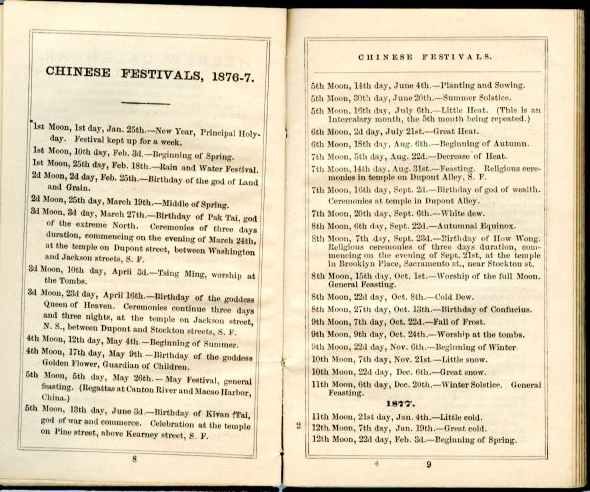
Chinese Festivals - Bancroft's Pacific Coast Diary 1876 (Collection of David Kelley)
1876 Oct 16 - Ah Chee & Co. The old Hoerchner lot was assessed to Ah Chee & Co.
1876 Yen San Pong building advertised for a delinquent tax sale. (E1:12:2)
1876 Oct. 16 - Ah Chee sells to Fred Zwickert. (El:15:15)
1878 The B. F. Stevens picture (a traveling photographer in the area) shows very little construction in this area. (E1:12:3)
c1878 Ah Yee & Co. came into possession of three lots that Maria Doutremont had sold to Jean Casteret. Mined them. (El:13:107)
1879 May 30 - S. R. Lucas, Irish, aged 52, found dead near Deer Flat. Verdict, murdered by a Chinaman. (Source: A History of Tuolumne County, California - San Francisco: B.F. Alley, 1882)
1879 March - Sheriff sold these three lots to F. J. Schoettgen for $22.71 tax deed. (El:13:107)
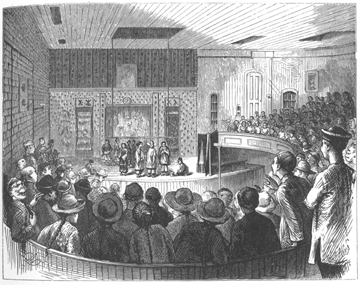
Inside a typical Chinese Theatre.
A Chinese Opera
1881 April 9 - "A number of enterprising Chinese have determined on erecting a building on the corner of Pacific and Main Street, Columbia, for theatrical purposes. Ah Long, the principal in the undertaking, informs us that sufficient stock has already been subscribed to warrant the carrying through of the project. In view of such facts, work will commence as soon as the required lumber can be obtained. Services of a Chinese Theatrical Troupe in Sacaramento have already been engaged for one month." (Source: Tuolumne Independant)
(While there appear to have been several Chinese Theaters in Columbia over the years, Louis Kress recalls one which stood opposite the Meysan ruins about 1900 where he attended the Columbia School. (Barbara Eastman - 1962)
The Chinese Theatre
1881 May 7 - "At the corner of Main and Pacific Streets, is nearing completion. There is a corps of skilled Chinese workmen from Sacramento, vigorously pushing the work. The plan upon which this structure is being built is a novelty to American architecture. Dimensions, 30'X80'; stage 25 feet deep. The floor of audience hall, or chamber, is laid on an incline, ascending from foot of stage, one foot in 20, which will give to the audience an unobstructed view of the performers without the inconvenience of climbing ladders." (Source: Tuolumne Independant)
Chinatown in an Uproar
1881 May 28 - "The new Chinese Theater opened this (Tuesday, May 24th) evening, with the play entitled, The Three Rival Suitors, taking three months, or ninety nights to play the entire piece. There are forty peformers to take part in the play. The theater is densely packed, with a good sprinkling of the caucasion. 'Heap no sabe Amelecan man!' The Cantons have us on a string." (Source: Tuolumne Independant) (....while the theater apparently was crowded the first night, their closing six weeks later suggests that the novelty apparently wore off as time went on. [Barbara Eastman - 1962])
Chinese Theater Closed
1881 July 9 - "The Chinese Theatrical troupe have closed their engagement and returned to the city (Sacramento) . They will perform again in November." (Source: Tuolumne Independant)
(If it opened again in November as promised, The Independant seems to have neglected to mention it. [Barbara Eastman - 1962])
1882 May 6 - A federal law passed in response to complaints by workers on the West Coast that competition from Chinese immigrants was driving down their wages. It suspended Chinese immigration for ten years and declared Chinese immigrants ineligible for naturalization as American citizens. The law was renewed in 1892 for another ten years, and in 1902 Chinese immigration was permanently banned. Chinese immigrants did not become eligible for citizenship until 1943.
See the Brief Overview.
1882 September - Ganello buys the building. (Its sale to Ganello...suggests that its popularity had been short lived. [Barbara Eastman - 1962])
Fire in Chinatown
1882 September 16 - "At 5-1/2 o'clock on the morning of Sunday September 10th a fire broke out in the Chinese Theater building, a large wooden structure on the southwest corner of Main and Pacific Streets, and before the rapid spread of the flames were checked eight buildings, including the theater were totally consumed, Chinese gambling houses and stores.
"The loss falls heaviest on Eloy, merchant, whose loss is estimated at $300. His store with the entire contents, was burned.
"The most amazing incident of the late fire, and the most novel in character, is the manner in which a Chinaman secured his wardrobe against damage by fire; about two hours after the occurance of the fire we observed a Chinaman taking (which we thought strange of having defied the ravanges of the fell destroyer) fancy goods and wearing apparel of every description worn by the celestrials, from a cask that stood in the smouldering ruins. On inquiry, we learned this Chinaman was old and feeble, and the fire pressing him closely, not having to carry articles from the houses, plunged them in a barrel of water left for that purpose, in case of emergency." (Source: Tuolumne Independant) (Its destruction by fire prevented even Ganello's use of the building. [Barbara Eastman - 1962])
The Fire Department was promptly on duty and did good service. They extenguished the fire, in a solid block of wooden houses, after it had made a clean sweep of all the buildings on the west side of Main Street, half way down to Jackson Street, The charred walls of the buildings in the outskirts of the surrounding ruins testify to the gallantry and efficiency of the Columbia Fire Department. No. 1 Engine took postion at the cistern on Jackson Street near Main Street nearest the scene of the fire, but were compelled to abandon it before getting to work, the heat was so intense; they, however, soon rallied, removed their scorching machine and took suction from the cistern on the corner of Broadway and Jackson Streets and got a stream on the left flank of the fire and headed it off in Ramon's hay barn, which was burned with three tons of hay. The total loss by fire is estimated at $5000. The fire is supposed to be the work of an inceniary.
"E. Heinckleman, a member of No. 2 Engine Company fell and was run over by a hose carrieage and quite severely injured about the head, though not considered dangerous." (Source: Tuolumne Independant)

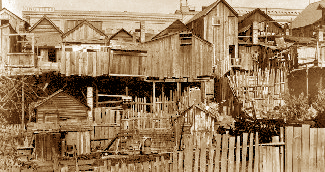
typical Chinatown late 1800s.
1880s-90 Chin Wow (Chinese prostitute) owned a house on Main Street (north side of Jackson Street). (she died in 1901).
1880s-90 Hog Mary (Chinese prostitute). Was called that due to her size and body shape. She also was known for her sharp loud voice. She moved to Knights Ferry in 1890's.
1898 Deeds (and 1907) refer to the old Claverie-Meysan and Juan Cuesta lots as Chinatown on east side of Main north of Jackson. (E1:12:3)
c1930s Chinese are sent home. The practice of secondary burial and removal meant that many former cemeteries are considered as having no Chinese buried there. This is not a valid conclusion because not all bodies were removed and returned to China; in particular, women (many of whom were prostitutes) seldom participated in the arrangements which funded the systematic removal. Others were not exhumed because they failed to pay for the service.
1954 A sign existed in Columbia with Chinese characters that stated, "The Sun was Shining on the Good People." With "donors" names listed as Mah In Teng, Mah In Ying, Mah Yen Bon, Chu Nook Wa. The sign is c1860-70.
Usually signs like this were for a merchant to add to his prosperity. They had nothing to do with the name of the store.
c1958 Chinese herb shop exhibit was installed in Bayhaut Building.
1963 December 13 - Ah Fah who was also known as Rose Smith died in Columbia and was buried East of Hill(Page 5, Plot 44) She was born in Jamestown, Ca. 12 September 1875 and Died in Columbia at age 88. (This was discovered by Becky Steiner - 2015)
1995 July 15 - A memorial was erected for the Chinese buried/removed in the cemetery.
It states: To Honor the Chinese Pioneers
This marks the burial site of Columbia's early Chinese miners and merchants. In keeping with their traditions, the remains have been disinterred and returned to their homeland.
Dedicated by Golden Era Parlor #99 N.D.G.W. July 15, 1995

Today we see some of the results of the Chinese presence in the gold fields with the stink weed called Tree of Heaven. Also known as ailanthus, Chinese sumac, and stinking sumac. It was brought here because it was one of the oldest medicinal recipes, recorded in a work from 732 AD, it was used for treating mental illness.
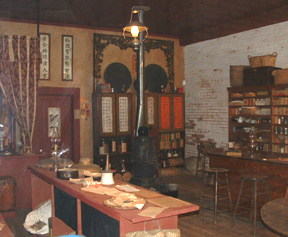
© Floyd D. P. Øydegaard.
Part of the Chinese Display - 2007

The Chinese Exclusion Act (1882): Brief Overview
"The Chinese Exclusion Act of 1882
was the first significant law
that restricted immigration into the United States of an ethnic working group."
The history of immigration to the United States and the contribution of immigrants and successive generations of American-born ethnic groups are important and essential factors in the history of the United States and the study of American social, economic, political, and cultural life. Between 1870 and 1900, for example, nearly 12 million immigrants arrived in the United States for a range of economic, political, and social reasons. During the 1870s and 1880s, the majority came mainly from Northern Europe (Germany, Ireland, and England), followed by a mass immigration from Southern Europe between 1880-1920's. For example, during the period of 1880-1924 over 4 million Italians (mostly from Southern Italy) alone emigrated from Italy to the U.S. Also, a massive wave of Chinese immigrants arrived in the U.S., mainly on the West coast. By 1870, the Chinese were 8.6% of the total population of California and constituted 25% of the labor force. Chinese immigrants arrived on U.S. shores between the start of the California gold rush in 1849 and 1882, until the U.S. Congress enacted federal law in 1882 designed to prevent Chinese immigrants from entering or remaining in the U.S.
In 1882 the Chinese Exclusion Act was passed by the U.S.Congress and signed by President Chester A. Arthur. The Chinese Exclusion Act of 1882 was the first significant law that restricted immigration into the United States of an ethnic working group. It also was the first in a series of legislative, executive, and judicial acts by the U.S. Government in the late nineteenth and early twentieth centuries setting official immigration policies that many historians, scholars, and average citizens consider as racist. The Chinese Exclusion Act was followed by official U.S. government policy that excluded or limited by quota immigration by Japanese, Filipinos, and the whole range of peoples from Asian nations. After decades of massive immigration into the U.S. by Italians, Poles, Hungarians, and a wide range of European- based national, religious, and ethnic groups, the National Origins Act of 1924 enacted discriminatory quota restrictions against European immigrants to America. Immigration quotas based on ethnicity and race were not "officially" abolished until the revision of U.S. immigration statutes in 1965. Immigration issues and immigration laws, however, continue (especially in the post-9/11 America) to be the center of current political, cultural, and social debates.
The Chinese Exclusion Act of 1882, the first major ethnic group immigration exclusion policy in the U.S., provided a 10-year moratorium on Chinese labor immigration. The Act states that "in the opinion of the Government of the United States the coming of Chinese laborers to this country endangers the good order of certain localities within the territory . . . Therefore, Be it enacted by the Senate and House of Representatives of the United States of America in Congress assembled, That from and after the expiration of ninety days next after the passage of this act, and until the expiration of ten years next after the passage of this act, the coming of Chinese laborers to the United States be, and the same is hereby, suspended; and during such suspension it shall not be lawful for any Chinese laborer to come, or, having so come after the expiration of said ninety days, to remain within the United States."
The Chinese Exclusion Act also required Chinese "non-laborers" in China who desired to enter the U.S. to obtain certification from the Chinese government that declared that they were qualified to immigrate. This group, however, faced difficulty legally proving that they were not laborers because the exclusion act defined excludable as "skilled and unskilled laborers and Chinese employed in mining." By this "definition" very few Chinese could enter the country under the 1882 law. The Chinese already in the U.S. also faced new requirements under the 1882 act. The Act states that if they left the United States, they needed to obtain re-entry certification. Congress also refused State and Federal courts the right to grant citizenship to Chinese resident aliens. These courts, however, still had the legal power to deport Chinese from the U.S. The exclusion act expired in 1892, but through the Geary Act, Congress extended it for 10 years. This extension (made permanent by a Congressional action in 1902) added restrictions by the requirement of the registration of every Chinese resident in the U.S. and the need for a certificate of residency to avoid legal action resulting in deportation. The Chinese Exclusion Act was the law of the land until Congress finally repealed it in 1943.
The "Anti-Chinese Movement and Exclusion" theme section in the Chinese in California: 1850-1925 web site (item 65) contains (starting on page 6) the text of the 1882 Chinese Exclusion Act (called "Treaty Concerning the Immigration of Chinese"):
http://memory.loc.gov/ammem/award99/cubhtml/themes.html

Most information comes from the following sourses unless where noted:
personal journals and first hand accounts
census records
World Book Encyclopdia
Columbia Archives.

This page is created for the benefit of the public by
Floyd D. P. Øydegaard

Email contact:
fdpoyde3 (at) Yahoo (dot) com
A WORK IN PROGRESS,
created for the visitors to the Columbia State Historic park.
© Columbia State Historic Park & Floyd D. P. Øydegaard.




















